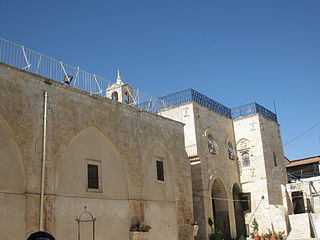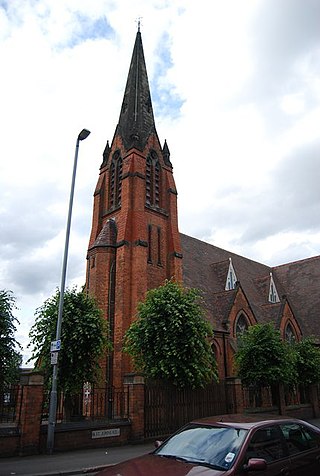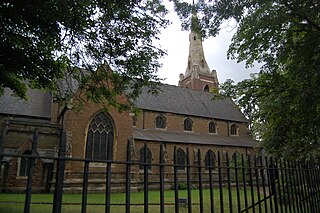
The Catholic Church in Gibraltar is part of the worldwide Catholic Church, under the spiritual leadership of the Pope in Rome. There are an estimated 23,000 baptised Catholics in Gibraltar, making up 72 percent of the population.

St Andrew's Church was a congregation of the Church of Scotland in the British overseas territory of Gibraltar and was part of the Presbytery of Europe. The church was opened in 1854. Whilst originally built primarily to serve as a garrison church for Scottish soldiers based in Gibraltar, it served the wider Presbyterian and Reformed Christian community of all nationalities.

Kyros or Cyrus was the Ecumenical Patriarch of Constantinople from 705 to 712. He is regarded as a saint in the Eastern Orthodox Church and Roman Catholic Church, which had set his feast for January 7 in Roman Catholic Church and January 8 (21) in Orthodox Church. Cyrus was placed on the patriarchal throne in 705 by Emperor Justinian II, as a replacement for the deposed Patriarch Callinicus I. Soon after Justinian's decline and eventual fall in December 711, Kyros was replaced by the new Emperor Philippicus with Patriarch John VI, who shared Philippicus' Monothelite sympathies.

Church of Saint Toros is an Armenian Orthodox church in the Armenian Quarter of Jerusalem.
The Eparchy of Saint Thomas the Apostle is a Chaldean Catholic diocese in Sydney, Australia, and is immediately subject to the Holy See.

The Diocese of Armagh is the metropolitan diocese of the ecclesiastical province of Armagh, the Church of Ireland province that covers the northern half (approximately) of the island of Ireland. The diocese mainly covers counties Louth, Tyrone and Armagh, and parts of Down. The diocesan bishop is also the Archbishop of Armagh, the archbishop of the province, and the Primate of All Ireland. The Archbishop has his seat in St Patrick's Cathedral in the town of Armagh.

Saint Patrick's Church is a Roman Catholic church located near St. Thomas Mount, in Chennai, India. From 1887, the church at the foot of St.Thomas Mount had been used as the Parish Church as it was convenient for the growing population.

Old St. Patrick's Church, also known as St. Patrick's Roman Catholic Church and commonly known as Old St. Pat's, is a Roman Catholic parish in Chicago, Illinois. Located at 700 West Adams Street, it has been described as the "cornerstone of Irish culture" in Chicago. The main church building is one of a handful of structures remaining in the city that predate the 1871 Great Chicago Fire, and is the city's oldest standing church building. As well as the 24th oldest building in the state.

St. Andrew's Church in Egmore, Chennai, India was built to serve the Scottish community in Chennai. Building started 6 April 1818 and the church was consecrated in 1821. It is one of the oldest churches in Madras. Its design was modelled on St Martin-in-the-Fields and along with St. George's Church, Dublin, it is considered one of the finest stylistic "daughter" churches to the famous Trafalgar Square structure.
St. Gabriel's Roman Catholic Church is a parish located in the Riverdale section of The Bronx, New York. The parish was created in 1939 by Francis Spellman, then the Archbishop of New York, as the successor to the St. Gabriel's Church on East 37th Street in Manhattan, which was razed in 1937 to accommodate the construction of the Queens–Midtown Tunnel. A total of 28 lots were purchased on the south side of West 235th Street between Arlington and Netherland avenues to house the new church, school, and rectory.

St John's Church is an Anglican church in Sparkhill Birmingham.

The Church of St. Catherine of Siena is a Roman Catholic parish church in the Roman Catholic Archdiocese of New York, located at 411 East 68th Street, Manhattan, New York City. The parish was developed from that of St. Vincent Ferrer in 1896. It is staffed by the Dominican Fathers.

The Church of St. Patrick is a parish church under the authority of the Roman Catholic Archdiocese of New York, located in Richmondtown, Staten Island, New York City.
The St. James Church is a Roman Catholic parish and church, located in St James, Cape Town, South Africa. The large church building was built in c. 1900.

St Michael's Church in St Michael's Road, Handsworth, Birmingham, England, is a Grade II listed, Church of England church, in the Diocese of Birmingham, built in 1851–1855, and described as "a major local landmark".
The Church of St Margaret of Scotland, also known as St Margarets Catholic Church, is a Roman Catholic church on St Margaret's Road in St Margarets, Twickenham, in the London Borough of Richmond upon Thames. The parish was created in 1936. The church building was designed by the architect Austin Winkley who was an influential architect of the Liturgical Movement. It opened in 1969. In 1999 it became a Grade II listed building.

Saint Sarkis Church is an Armenian Apostolic church in Baron Avak neighborhood of Tabriz, Iran. St. Sarkis was built with funding from the Petrossian family. Built in 1845, the church is in the courtyard of Tamarian Armenian school building, which was extended out to add the Sahakian School. The Haykazyan school was located across from these, but was closed after being damaged in the Iran-Iraq war.

Saint John the Baptist Church of New Julfa,, is an Armenian Apostolic church in New Julfa, Iran. It is located in Charsou neighbourhood of New Julfa, next to St. Catherine Convent.

Saint Nicholas Church of New Julfa,, is an Armenian Apostolic church in New Julfa, Iran. It is located in Gharagel neighbourhood of New Julfa.

The Greek Orthodox Cathedral of St George is the Greek Orthodox church of Cape Town, South Africa, located in the district of Woodstock, and the seat of the Metropolitan of the Orthodox Archdiocese of Good Hope, under the Patriarchate of Alexandria and All Africa.

















